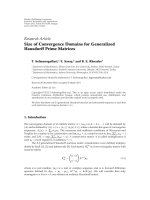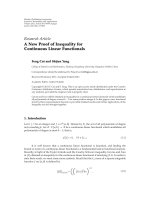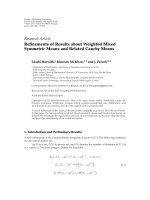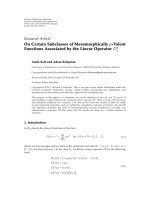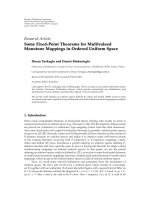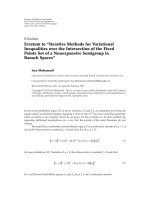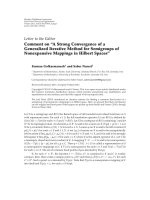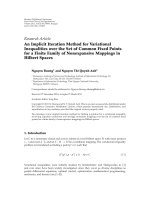Hindawi Publishing Corporation Advances in Difference Equations Volume 2011, Article ID 385324, 16 docx
Bạn đang xem bản rút gọn của tài liệu. Xem và tải ngay bản đầy đủ của tài liệu tại đây (537.08 KB, 16 trang )
Hindawi Publishing Corporation
Advances in Difference Equations
Volume 2011, Article ID 385324, 16 pages
doi:10.1155/2011/385324
Research Article
Study of an Approximation Process of
Time Optimal Control for Fractional Evolution
Systems in Banach Spaces
JinRong Wang
1
and Yong Zhou
2
1
Department of Mathematics, Guizhou University, Guiyang, G uizhou 550025, China
2
Department of Mathematics, Xiangtan University, Xiangtan, Hunan 411105, China
Correspondence should be addressed to Yong Zhou,
Received 1 October 2010; Accepted 9 December 2010
Academic Editor: J. J. Trujillo
Copyright q 2011 J. Wang and Y. Zhou. This is an open access article distributed under the
Creative Commons Attribution License, which permits unrestricted use, distribution, and
reproduction in any medium, provided the original work is properly cited.
The paper is devoted to the study of an approximation process of time optimal control for fractional
evolution systems in Banach spaces. We firstly convert time optimal control problem into Meyer
problem. By virtue of the properties of the family of solution operators given by us, the existence
of optimal controls for Meyer problem is proved. Secondly, we construct a sequence of Meyer
problems to successive approximation of the original time optimal control problem. Finally, a new
approximation process is established to find the solution of time optimal control problem. Our
method is different from the standard method.
1. Introduction
It has been shown that the accurate modelling in dynamics of many e ngineering, physics,
and economy systems can be obtained by using fractional differential equations. Numerous
applications can be found in viscoelasticity, electrochemistry, control, porous media,
electromagnetic, and so forth. There has been a great deal of interest in the solutions
of fractional differential equations in analytical and numerical sense. One can see the
monographs of Kilbas et al. 1, Miller and Ross 2,Podlubny3, and Lakshmikantham et al.
4. The fractional evolution equations in infinite dimensional spaces attract many authors
including us see, for instance, 5–21 and the references therein.
When the fractional differential equations describe the performance index and
system dynamics, a classical optimal control problem reduces to a fractional optimal
control problem. The optimal control of a fractional dynamics system is a fractional
optimal control with system dynamics defined with partial fractional differential equations.
2AdvancesinDifference Equations
There h as been very little work in the area of fractional optimal control pr oblems 18, 22,
especially the time optimal control for fractional evolution equations 19. Recalling that the
research on time optimal control problems dates back to the 1960s, many problems such as
existence and necessary conditions for optimality and controllability have been discussed, for
example, see 23 for the finite dimensional case and 7, 24–37 for the infinite dimensional
case. Since the cost functional for a time optimal control problem is the infimum of a number
set, it is different with the Lagrange problem, the Bolza problem and the Meyer problem,
which arise some new difficulties. As a result, we regard the time optimal control as another
problem which is not the same as the above three problems.
Motivated by our previous work in 18–21, 38, we consider the time optimal control
problem P of a fractional evolution system governed by
C
D
q
t
z
t
Az
t
f
t, z
t
,B
t
v
t
,t∈
0,τ
,q∈
0, 1
,
z
0
z
0
∈ X, v ∈ V
ad
,
1.1
where
C
D
q
t
is the Caputo fractional derivative of order q, A : DA → X is the infinitesimal
generator of a strongly continuous semigroup {Tt,t ≥ 0}, V
ad
is the admissible control set
and f : I
τ
:0,τ × X × X → X will be specified latter.
Let us mention, we do n ot study the time optimal control problem P of the above
system by standard method used in our earlier work 19. In the present paper, we will
construct a sequences of Meyer problems P
ε
n
to successive approximation time optimal
control problem P. Therefore, we need introduce the following new fractional evolution
system
C
D
q
s
x
s
k
q
Ax
s
k
q
f
ks,x
s
,B
ks
u
s
,s∈
0, 1
,
x
0
z
0
∈ X, w
u, k
∈ W,
1.2
whose controls are taken from a product space W will be specified latter.
By applying the family of solution operators T
k
and S
k
see Lemma 3.7 associated
with the family of C
0
-semigroups with parameters and some probability density functions,
the existence of optimal controls f or Meyer problems P
ε
is proved. Then, we show that
there exists a subsequence of Meyer problems P
ε
n
whose corresponding sequence of optimal
controls {w
ε
n
}∈W converges to a time optimal control of problem P in some sense. In other
words, in a limiting process, the sequence {w
ε
n
}∈W can be used to find the solution of time
optimal control problem P. The existence of time optimal controls for problem P is proved
by this constructive approach which provides a new method to solve the time optimal control.
The rest of the paper is organized as follows. In Section 2, some notations and
preparation results are given. In Section 3,weformulatethetimeoptimalcontrolproblemP
and Meyer problem P
ε
.InSection 4, the existence of optimal controls for Meyer problems
P
ε
is proved. Finally, we display the Meyer approximation process of time optimal control
and derive the main result of this paper.
Advances in Difference Equations 3
2. Preliminaries
Throughout this paper, we denote by X a Banach space with the norm ·.Foreachτ<
∞,letI
τ
≡ 0,τ and CI
τ
,X be the Banach space of continuous functions from I
τ
to X
with the usual supremum norm. Let A : DA → X be the infinitesimal generator of a
strongly continuous semigroup {Tt,t ≥ 0}. This means that there exists M>0suchthat
sup
t∈I
τ
Tt≤M. We will also use f
L
p
I
τ
,R
to denote the L
p
I
τ
,R
norm of f whenever
f ∈ L
p
I
τ
,R
for some p with 1 <p<∞.
Let us recall the following definitions in 1.
Definition 2.1. The fractional integral of order γ with the lower limit zero for a function f is
defined as
I
γ
f
t
1
Γ
γ
t
0
f
s
t − s
1−γ
ds, t > 0,γ>0, 2.1
provided the right side is pointwise defined on 0, ∞,whereΓ· is the gamma function.
Definition 2.2. Riemann-Liouville derivative of order γ with the lower limit zero for a function
f : 0, ∞ → R can be written as
L
D
γ
f
t
1
Γ
n − γ
d
n
dt
n
t
0
f
s
t − s
γ1−n
ds, t > 0,n− 1 <γ <n. 2.2
Definition 2.3. The Caputo derivative of order γ for a function f : 0, ∞ → R can be written
as
C
D
γ
f
t
L
D
γ
f
t
−
n−1
k0
t
k
k!
f
k
0
,t>0,n− 1 <γ<n. 2.3
Remark 2.4. i If ft ∈ C
n
0, ∞,then
C
D
γ
f
t
1
Γ
n − γ
t
0
f
n
s
t − s
γ1−n
ds I
n−γ
f
n
t
,t>0,n− 1 <γ<n. 2.4
ii The Caputo derivative of a constant is equal to zero.
iii If f is an abstract function with values in X, then integrals which appear in
Definitions 2.1 and 2.2 are taken in Bochner’s sense.
Lemma 2.5 see 38, Lemma 3.1. If the assumption [A] holds, then
1 for given k ∈ 0,
T, kA is the i nfinitesimal generator of C
0
-semigroup {T
k
t,t≥ 0} on X,
2 there exist constants C ≥ 1 and ω ∈ −∞, ∞ such that
T
k
t
≤ Ce
ωkt
, ∀t ≥ 0,
2.5
4AdvancesinDifference Equations
3 if k
n
→ k
ε
in 0,
T as n →∞, then for arbitrary x ∈ X and t ≥ 0,
T
k
n
t
s
−→ T
k
ε
t
, as n −→ ∞
2.6
uniformly in t on some closed interval of 0,
T in the strong operator topology sense.
3. System Description and Problem Formulation
Consider the following fractional nonlinear controlled system
C
D
q
t
z
t
Az
t
f
t, z
t
,B
t
v
t
,t∈
0,τ
,
z
0
z
0
∈ X, v ∈ V
ad
.
3.1
We make the following assumptions.
A : A is the infinitesimal generator of a C
0
-semigroup {Tt,t ≥ 0} on X with domain
DA.
F : f : I
τ
× X × X → X is measurable in t on I
τ
and for each ρ>0, there exists a
constant Lρ > 0 such that for almost all t ∈ I
τ
and all z
1
,z
2
,y
1
,y
2
∈ X, satisfying
z
1
, z
2
, y
1
, y
2
≤ρ,wehave
f
t, z
1
,y
1
− f
t, z
2
,y
2
≤ L
ρ
z
1
− z
2
y
1
− y
2
. 3.2
For arbitrary t, z, y ∈ I
τ
× X × X, there exists a positive constant M>0suchthat
f
t, z, y
≤ M
1
z
y
. 3.3
B :LetE be a separable reflexive Banach space, B ∈ L
∞
I
τ
,LE, X, B
∞
stands
for the norm of operator B on Banach space L
∞
I
τ
,LE, X. B : L
p
I
τ
,E →
L
p
I
τ
,X1 <p<∞ is strongly continuous.
U :MultivaluedmapsV· : I
τ
→ 2
E
\{Ø} has closed, convex and bounded values.
V· is graph measurable and V· ⊆ Ω where Ω is a bounded set of E.
Set
V
ad
{
v
·
| I
τ
−→ E measurable,v
t
∈V
t
a.e.
}
. 3.4
Obviously, V
ad
/
Ø see 39,Theorem2.1 and V
ad
⊂ L
p
I
τ
,E1 <p<∞ is bounded,
closed and convex.
Based on our previous work 21, Lemma 3.1 and Definition 3.1,weusethefollowing
definition of mild solutions for our problem.
Advances in Difference Equations 5
Definition 3.1. By the mild solution of system 3.1, we mean that the function x ∈ CI
τ
,X
which satisfies
z
t
T
t
z
0
t
0
t − θ
q−1
S
t − θ
f
θ, z
θ
,B
θ
v
θ
dθ, t ∈ I
τ
, 3.5
where
T
t
∞
0
ξ
q
θ
T
t
q
θ
dθ, S
t
q
∞
0
θξ
q
θ
T
t
q
θ
dθ,
ξ
q
θ
1
q
θ
−1−1/q
q
θ
−1/q
≥ 0,
q
θ
1
π
∞
n1
−1
n−1
θ
−qn−1
Γ
nq 1
n!
sin
nπq
,θ∈
0, ∞
,
3.6
ξ
q
is a probability density function defined on 0, ∞,thatis
ξ
q
θ
≥ 0,θ∈
0, ∞
,
∞
0
ξ
q
θ
dθ 1. 3.7
Remark 3.2. i It is not difficult to verify that for v ∈ 0, 1
∞
0
θ
v
ξ
q
θ
dθ
∞
0
θ
−qv
q
θ
dθ
Γ
1 v
Γ
1 qv
.
3.8
ii For another suitable definition of mild solutions for fractional differential
equations, the reader can refer to 13.
Lemma 3.3 see 21, Lemmas 3.2-3.3. The operators T and S have the following properties.
i For any fixed t ≥ 0, Tt and St are linear and bounded operators; that is, for any x ∈ X,
T
t
x
≤ M
x
,
S
t
x
≤
qM
Γ
1 q
x
.
3.9
ii {Tt,t≥ 0} and {St,t≥ 0} are strongly continuous.
We present the following existence and uniqueness of mild solutions for system 3.1.
Theorem 3.4. Under the assumptions [A], [B], [F] and [U], for every v ∈ V
ad
and pq > 1,system
3.1 has a unique mild solution z ∈ CI
τ
,X which satisfies the following integral equation
z
t
T
t
z
0
t
0
t − θ
q−1
S
t − θ
f
θ, z
θ
,B
θ
v
θ
dθ. 3.10
6AdvancesinDifference Equations
Proof. Consider the ball given by B {x ∈ C0,T
1
,X |xt − x
0
≤1, 0 ≤ t ≤ T
1
},where
T
1
would be chosen, and xt≤1 x
0
ρ,0≤ t ≤ T
1
, B⊆C0,T
1
,X is a closed convex
set. Define a map H on B given by
Hz
t
T
t
z
0
t
0
t − θ
q−1
S
t − θ
f
θ, z
θ
,B
θ
v
θ
dθ. 3.11
Note that by the properties of T and S, assumptions A, F, B,andU,bystandard
process see 19,Theorem3.2, one can verify that H is a contraction map on B with T
1
> 0.
This means that system 3.1 has a unique mild solution on 0 ,T
1
. Again, using the singular
version Gronwall inequality, we can obtain the a prior estimate of the mild solutions of system
3.1 and present the global existence of the mild solutions.
Definition 3.5 admissible trajectory.Taketwopointsz
0
, z
1
in the state space X.Letz
0
be the
initial state and let z
1
be the desired terminal state with z
0
/
z
1
,denotezv ≡{zt, v ∈ X |
t ≥ 0} be the state trajectory corresponding to the control v ∈ V
ad
. A trajectory zv is said to
be admissible if z0,vz
0
and zt, vz
1
for some finite t>0.
Set V
0
{v ∈ V
ad
| zv is an admissible trajectory}⊂V
ad
. For given z
0
,z
1
∈ X and
z
0
/
z
1
,ifV
0
/
Ø i.e., there exists at least one control from the admissible class that takes the
system from the given initial state z
0
to the desired ta rget state z
1
in the finite time.,wesay
the system 3.1 can be controlled.
Let τv ≡ inf{t ≥ 0 | zt, vz
1
} denote the transition time corresponding to the
control v ∈ V
0
/
Øanddefineτ
∗
inf{τv ≥ 0 | v ∈ V
0
}.
Then, the time optimal control problem can be stated as follows.
Problem Problem P.Taketwopointsz
0
, z
1
in the state space X.Letz
0
be the initial state
and let z
1
be the desired terminal state with z
0
/
z
1
. Suppose that there exists at least one
control from the admissible class that takes the system from the given initial state z
0
to the
desired target state z
1
in the finite time. The time optimal control problem is to find a control
v
∗
∈ V
0
such that
τ
v
∗
τ
∗
inf
{
τ
v
≥ 0 | v ∈ V
0
}
. 3.12
For fixed v ∈ V
ad
,
T τv > 0. Now, we introduce the following linear transformation
t ks, 0 ≤ s ≤ 1,k∈
0,
T
. 3.13
Through this transformation, system 3.1 can be replaced by
C
D
q
s
x
s
k
q
Ax
s
k
q
f
ks,x
s
,B
ks
u
s
,s∈
0, 1
,
x
0
z
0
z
0
∈ X, w
u, k
∈ W,
3.14
Advances in Difference Equations 7
where x·zk·, u·vk·,anddefine
W
u, k
| u
s
v
ks
, 0 ≤ s ≤ 1,v∈ V
ad
,k∈
0,
T
. 3.15
By Theorem 3.4, one can obtain the following existence result.
Theorem 3.6. Under the assumptions of Theorem 3.4, for every w ∈ W and pq > 1,system3.14
has a unique mild solution x ∈ C0, 1,X which satisfies the following integral equation
x
s
T
k
s
z
0
s
0
s − θ
q−1
S
k
s − θ
kf
kθ, x
θ
,B
kθ
u
θ
dθ, 3.16
where
T
k
s
∞
0
ξ
q
θ
T
k
q
s
q
θ
dθ, S
k
s
q
∞
0
θξ
q
θ
T
k
q
s
q
θ
dθ, 3.17
and {T
k
q
t,t≥ 0} is a C
0
-semigroup generated by the infinitesimal generator k
q
A.
By Lemmas 2.5 and 3.3,itisnotdifficult to verify the following result.
Lemma 3.7. The family of solution operators T
k
and S
k
given by 3.17 has the following properties.
i For any x ∈ X, t ≥ 0, there exists a constant C
k
q
> 0 such that
T
k
t
x
≤ C
k
q
x
,
S
k
t
x
≤
qC
k
q
Γ
1 q
x
.
3.18
ii {T
k
t,t≥ 0} and {S
k
t,t≥ 0} are also strongly c ontinuous.
iii If k
q
n
→ k
q
ε
in 0,
T as n →∞, then for arbitrary x ∈ X and t ≥ 0
T
k
q
n
t
s
−→ T
k
q
ε
t
, as n −→ ∞ ,
S
k
q
n
t
s
−→ S
k
q
ε
t
, as n −→ ∞
3.19
uniformly in t on some closed interval of 0,
T in the strong operator topology sense.
For system 3.14, we turn to consider the following Meyer problem.
8AdvancesinDifference Equations
Meyer Problem P
ε
Minimize the cost functional given by
J
ε
w
1
2ε
x
w
1
− z
1
2
k
3.20
over W,wherexw is the mild solution of 3.14 corresponding to control w,thatis,finda
control w
ε
u
ε
,k
ε
such that the cost functional J
ε
w attains its minimum on W at w
ε
.
4. Existence of Optimal Controls for Meyer Problem P
ε
In this section, we discuss the existence of optimal controls for Meyer problem P
ε
.
We show that Meyer problem P
ε
has a solution w
ε
u
ε
,k
ε
for fixed ε>0.
Theorem 4.1. Under the assumptions of Theorem 3.6. Meyer problem P
ε
has a solution.
Proof. Let ε>0befixed.SinceJ
ε
w ≥ 0, there exists inf{J
ε
w,w ∈ W}.Denotem
ε
≡
inf{J
ε
w,w ∈ W} and choose {w
n
}⊆W such that J
ε
w
n
→ m
ε
where w
n
u
n
,k
n
∈ W
V
ad
× 0,
T. By assumption U, there exists a subsequence {u
n
}⊆V
ad
such that u
n
w
→ u
ε
in V
ad
as n →∞,andV
ad
is closed and convex, thanks to Mazur Lemma, u
ε
∈ V
ad
.By
assumption B ,wehave
Bu
n
s
−→ Bu
ε
, in L
p
0, 1
,X
, as n −→ ∞ .
4.1
Since k
n
k
q
n
is bounded and k
n
k
q
n
> 0, there also exists a subsequence {k
n
}{k
q
n
} denoted
by {k
n
}{k
q
n
} ⊆ 0,
T again, such that
k
n
k
q
n
−→ k
ε
k
q
ε
, in
0,
T
, as n −→ ∞ . 4.2
Let x
n
and x
ε
be the mild solutions of system 3.14 corresponding to w
n
u
n
,k
n
∈
W and w
ε
u
ε
,k
ε
∈ W, respectively. Then, we have
x
n
s
T
n
s
z
0
s
0
s − θ
q−1
S
n
s − θ
k
q
n
F
n
θ
dθ,
x
ε
s
T
ε
s
z
0
s
0
s − θ
q−1
S
ε
s − θ
k
q
ε
F
ε
θ
dθ,
4.3
Advances in Difference Equations 9
where
T
n
·
≡
∞
0
ξ
q
θ
T
k
q
n
·
q
θ
dθ,
S
n
·
≡ q
∞
0
θξ
q
θ
T
k
q
n
·
q
θ
dθ,
F
n
·
≡ f
k
n
·,x
n
·
,B
k
n
·
u
n
·
,
T
ε
·
≡
∞
0
ξ
q
θ
T
k
q
ε
·
q
θ
dθ,
S
ε
·
≡ q
∞
0
θξ
q
θ
T
k
q
ε
·
q
θ
dθ,
F
ε
·
≡ f
k
ε
·,x
ε
·
,B
k
ε
·
u
ε
·
.
4.4
By Lemma 3.7, assumptions F, B, U, and singular version Gronwall Lemma, it is easy to
verify that there exists a constant ρ>0suchthat
x
ε
C0,1,X
≤ ρ,
x
n
C0,1,X
≤ ρ.
4.5
Further, there exists a constant M
ε
> 0suchthat
F
ε
C0,1,X
≤ M
ε
1 ρ
B
∞
max
t∈0,1
{
u
t
}
.
4.6
Denote
R
1
T
n
s
z
0
−T
ε
s
z
0
,
R
2
s
0
s − θ
q−1
S
n
s − θ
k
q
n
F
n
θ
dθ −
s
0
s − θ
q−1
S
n
s − θ
k
q
n
F
ε
n
θ
dθ
,
R
3
s
0
s − θ
q−1
S
n
s − θ
k
q
n
F
ε
n
θ
dθ −
s
0
s − θ
q−1
S
ε
s − θ
k
q
ε
F
ε
θ
dθ
,
4.7
where
F
ε
n
θ
≡ f
k
n
θ, x
ε
θ
,B
k
ε
θ
u
ε
θ
. 4.8
10 Advances in Difference Equations
By assumption F,
R
2
≤
qC
k
q
n
k
q
n
Γ
1 q
s
0
s − θ
q−1
F
n
θ
− F
ε
n
θ
dθ
≤
qC
k
q
n
k
q
n
L
ρ
Γ
1 q
s
0
s − θ
q−1
x
n
θ
− x
ε
θ
dθ
qC
k
q
n
k
q
n
L
ρ
Γ
1 q
s
0
s − θ
q−1
B
k
n
θ
u
n
θ
− B
k
ε
θ
u
ε
θ
dθ
≤ R
21
R
22
R
23
,
4.9
where
M
k
q
n
≡
qC
k
q
n
k
q
n
L
ρ
Γ
1 q
,
R
21
≡ M
k
q
n
s
0
s − θ
q−1
x
n
θ
− x
ε
θ
dθ,
R
22
≡ M
k
q
n
s
0
s − θ
q−1
B
k
n
θ
u
ε
θ
− B
k
ε
θ
u
ε
θ
dθ,
R
23
≡ M
k
q
n
s
0
s − θ
q−1
B
k
n
θ
u
n
θ
− B
k
n
θ
u
ε
θ
dθ,
R
3
≤
s
0
s − θ
q−1
k
q
n
S
n
s − θ
F
ε
n
θ
− k
q
ε
S
n
s − θ
F
ε
θ
dθ
k
q
ε
s
0
s − θ
q−1
S
n
s − θ
F
ε
θ
−S
ε
s − θ
F
ε
θ
dθ
≤ R
31
R
32
R
33
,
4.10
where
R
31
≡ M
k
q
n
k
q
n
s
0
s − θ
q−1
F
ε
n
θ
− F
ε
θ
dθ,
R
32
≡ M
k
q
n
s
0
s − θ
q−1
k
q
n
− k
q
ε
F
ε
θ
dθ,
R
33
≡ k
q
ε
M
ε
1 ρ
s
0
s − θ
q−1
S
n
s − θ
−S
ε
s − θ
dθ.
4.11
Advances in Difference Equations 11
Note that Lemma 3.7 and 4.1, combining H
¨
older inequality with Lebesgue domi-
nated convergence theorem, one can verify R
1
→ 0, R
23
→ 0, R
31
→ 0andR
33
→ 0
as n →∞immediately. Since k
n
k
q
n
→ k
ε
k
q
ε
as n →∞, F
ε
C0,1,X
and u
ε
t
E
are
bounded, R
22
→ 0, R
32
→ 0asn →∞.
Then, we obtain that
x
n
s
− x
ε
s
≤ R
1
R
2
R
3
≤ σ
ε
M
k
q
n
s
0
s − θ
q−1
x
n
θ
− x
ε
θ
dθ,
4.12
where
σ
ε
R
1
R
22
R
23
R
31
R
32
−→ 0, as n −→ ∞ . 4.13
By singular version Gronwall Lemma again, we obtain
x
n
s
−→ x
ε
, in C
0, 1
,X
, as n −→ ∞ .
4.14
Thus, there exists a unique control w
ε
u
ε
,k
ε
∈ W such that
m
ε
lim
n →∞
J
ε
w
n
J
ε
w
ε
≥ m
ε
.
4.15
This shows that J
ε
w attains its minimum at w
ε
∈ W, and hence x
ε
is the solution of system
3.14 corresponding to control w
ε
.
5. Meyer Approximation Process of Time Optimal Control
In this section, we display the Meyer approximation process of the time optimal control
problem P.
For the sake of convenience, we subdivide the approximation process into several
steps.
Step 1. By Theorem 4.1,thereexistsaw
ε
u
ε
,k
ε
∈ W such that J
ε
w attains its minimum
at w
ε
∈ W,thatis,
J
ε
w
ε
1
2ε
x
w
ε
1
− z
1
2
k
ε
inf
w∈W
J
ε
w
.
5.1
By controllability of problem P, V
0
/
Ø. Take v ∈ V
0
and let τvτ<∞ then
zvτz
1
.Defineusvτs,0≤ s ≤ 1and w u, τ ∈ W.Thenx·zvτ· is the
mild solution of system 3.14 corresponding to control w u, τ ∈ W.Ofcourse,wehave
x1z
1
.
12 Advances in Difference Equations
For any ε>0, submitting w to J
ε
,wehave
J
ε
w
τ ≥ J
ε
w
ε
1
2ε
x
w
ε
1
− z
1
2
k
ε
.
5.2
This inequality implies that
0 ≤ k
ε
≤ τ,
x
w
ε
1
− z
1
2
≤ 2ετ, hold for all ε>0.
5.3
We can choose a subsequence {ε
n
} such that ε
n
→ 0asn →∞and
k
q
ε
n
−→
k
q
0
, in
0,
T
,
k
ε
n
−→ k
0
, in
0,
T
,
x
w
ε
n
1
≡ x
ε
n
1
−→ z
1
, in X, as n −→ ∞ ,
u
ε
n
w
−→ u
0
, in V
ad
,w
ε
n
u
ε
n
,k
ε
n
∈ W.
5.4
Since V
ad
is closed and convex, thanks to Mazur Lemma again, u
0
∈ V
ad
.
Further, by assumption B,weobtain
k
q
ε
n
−→
k
q
0
, in
0,
T
,
k
ε
n
−→ k
0
, in
0,
T
,
x
w
ε
n
1
≡ x
ε
n
1
−→ z
1
, in X, as n −→ ∞ ,
Bu
ε
n
s
−→ Bu
0
, in L
p
0, 1
,X
.
5.5
Step 2. Let x
ε
n
and x
0
be the mild solutions of system 3.14 corresponding to w
ε
n
u
ε
n
,k
ε
n
∈
W and w
0
u
0
,k
0
∈ W, respectively. Then, we have
x
ε
n
s
T
ε
n
s
z
0
s
0
s − θ
q−1
S
ε
n
s − θ
k
q
ε
n
F
ε
n
θ
dθ,
x
0
s
T
0
s
z
0
s
0
s − θ
q−1
S
0
s − θ
k
q
0
F
0
θ
dθ,
5.6
Advances in Difference Equations 13
where
T
ε
n
·
≡
∞
0
ξ
q
θ
T
k
q
ε
n
·
q
θ
dθ,
S
ε
n
·
≡ q
∞
0
θξ
q
θ
T
k
q
ε
n
·
q
θ
dθ,
F
ε
n
·
≡ f
k
ε
n
·,x
ε
n
·
,B
k
ε
n
·
u
ε
n
·
,
T
0
·
≡
∞
0
ξ
q
θ
T
k
0
q
·
q
θ
dθ,
S
0
·
≡ q
∞
0
θξ
q
θ
T
k
0
q
·
q
θ
dθ,
F
0
·
≡ f
k
0
·,x
0
·
,B
k
0
·
u
0
·
.
5.7
Recalling 5.5 and the process in Theorem 4.1, after some calculation, using the singular
version Gronwall Lemma again, we also obtain
x
ε
n
s
−→
x
0
, in C
0, 1
,X
, as n −→ ∞ .
5.8
Step 3. It follows from Steps 1 and 2,
x
ε
n
1
− z
1
≤
2ε
n
τ −→ 0, as n −→ ∞ ,
x
ε
n
1
− x
0
1
−→ 0, as n −→ ∞ ,
x
0
1
− z
1
≤
x
ε
n
1
− z
1
x
ε
n
1
− x
0
1
−→ 0, as n −→ ∞ ,
5.9
that x
0
1z
1
. It is very clear that k
0
/
0unlessz
0
z
1
. This implies that k
0
> 0.
Define v
0
·u
0
·/k
0
.Infact,z
0
·x
0
·/k
0
is the mild solution of system 3.1
corresponding to control v
0
∈ V
0
,thenz
0
k
0
x
0
1z
1
and τv
0
k
0
> 0. By the
definition of τ
∗
inf{τv ≥ 0 | v ∈ V
0
},wehavek
0
≥ τ
∗
.
For any v ∈ V
0
,
τ
v
≥ J
ε
w
ε
1
2ε
x
w
ε
1
− z
1
2
k
ε
.
5.10
Thus, τv ≥ k
ε
.Further,τv ≥ k
ε
n
for all ε
n
> 0.
Since k
0
is the limit of k
ε
n
as n →∞, τv ≥ τv
0
k
0
for all v ∈ V
0
.Hence,k
0
≤ τ
∗
.
Thus, 0 <τv
0
k
0
τ
∗
. This implies that v
0
is an optimal control of Problem P and k
0
> 0
is just optimal time.
14 Advances in Difference Equations
Remark 5.1. Under the above assumptions, there exists a sequence of Meyer problems P
ε
n
whose corresponding sequence of optimal controls {w
ε
n
}∈W can successive approximation
thetimeoptimalcontrolproblemP in some sense. In other words, by limiting process, the
sequence of the optimal controls {w
ε
n
}∈W can be used to find the solution of time optimal
control problem P.
As a result, we obtain the existence result of time optimal control for system 3.1
directly.
Theorem 5 .2. Under the assumptions of Theorem 4.1. The time optimal control problem P has a
solution, that is, there exists an optimal control v
∗
∈ V
0
⊂ V
ad
such that
τ
v
∗
τ
∗
inf
{
τ
v
≥ 0 | v ∈ V
0
}
. 5.11
Acknowledgments
This research was supported by National Natural Science Foundation of China No.
10971173, Tianyuan Special Funds of National Natural Science Foundation of China No.
11026102, and National Natural Science Foundation of Guizhou Province 2010, No. 2142.
References
1 A. A. Kilbas, H. M. Srivastava, and J. J. Trujillo, Theory and Applications of Fractional Differential
Equations, vol. 204 of North-Holland Mathematics Studies, Elsevier Science B.V., Amsterdam, The
Netherlands, 2006.
2 K. S. Miller and B. Ross, An Introduction to the Fractional Calculus and Fractional Differential Equations,
A Wiley-Interscience Publication, John W iley & Sons, New York, NY, USA, 1993.
3 I. Podlubny, Fractional Differential Equations. An Introduction to Fractional Derivatives, Fractional
Differential Equations, to Methods of Their Solution and Some of Their Applications, vol. 198 of Mathematics
in Science and Engineering, Academic Press, San Diego, Calif, USA, 1999.
4 V. Lakshmikantham, S. L eela, and J. V. D evi, Theory of Fractional Dynamic Systems, Cambridge Scientific
Publishers, Cambridge, UK, 2009.
5 K. Balachandran and J. Y. Park, “Nonlocal Cauchy problem for abstract f ractional semilinear
evolution equations,” Nonlinear Analysis: Theory, Methods & Applications, vol. 71, no. 10, pp. 4471–4475,
2009.
6 K. Balachandran, S. Kiruthika, and J. J. Trujillo, “Existence results for fractional impulsive
integrodifferential equations in Banach spaces,” Communications in Nonlinear Science and Numerical
Simulation, vol. 16, no. 4, pp. 1970–1977, 2011.
7 K. Balachandran and J. Y. Park, “Controllability of fractional integrodifferential systems in Banach
spaces,” Nonlinear Analysis, vol. 3, no. 4, pp. 363–367, 2009.
8 M. Benchohra, J. Henderson, S. K. Ntouyas, and A. Ouahab, “Existence results for fractional order
functional differential equations with infinite delay,” Journal of Mathematical Analysis and Applications,
vol. 338, no. 2 , pp. 1340–1350, 2008.
9 Y K. C hang, V. Kavitha, and M. Mallika Arjunan, “Existence and uniqueness of mild solutions to
a semilinear integrodifferential equation of fractional order,” Nonlinear Analysis: Theory, Methods &
Applications, vol. 71, no. 11, pp. 5551–5559, 2009.
10 M. M. El-Borai, “Semigroups and some nonlinear fractional differential equations,” Applied
Mathematics and Computation, vol. 149, no. 3, pp. 823–831, 2004.
11
M. M. El-Borai, “The fundamental solutions for fractional evolution equations of parabolic type,”
Journal of Applied Mathematics and S tochastic Analysis, vol. 2004, no. 3, pp. 197–211, 2004.
12 J. Henderson and A. Ouahab, “ Fractional functional differential inclusions with finite delay,”
Nonlinear Analysis: Theory, Methods & Applications, vol. 70, no. 5, pp. 2091–2105, 2009.
Advances in Difference Equations 15
13 E. Hernndez, D. O’Regan, and K. Balachandran, “On recent developments in the theory of abstract
differential equations with fractional derivatives,” Nonlinear Analysis: Theory, Methods and Applications,
vol. 73, no. 10, pp. 3462–3471, 2010.
14 L. Hu, Y. Ren, and R. Sakthivel, “Existence and uniqueness of mild solutions for semilinear integro-
differential equations of fractional order with nonlocal initial conditions and delays,” Semigroup
Forum, vol. 79, no. 3, pp. 507–514, 2009.
15 O. K. Jaradat, A. Al-Omari, and S. Momani, “Existence of the mild solution for fractional semilinear
initial value problems,” Nonlinear Analysis: Theory, Methods & Applications, v ol. 69, no. 9, pp. 3153–
3159, 2008.
16 G. M. N’Gu
´
er
´
ekata, “A Cauchy problem for some fractional abstract differential equation with non
local conditions,” Nonlinear Analysis: Theory, Methods & Applications, vol. 70, no. 5, pp. 1873–1876, 2009.
17 G. M. Mophou and G. M. N’Gu
´
er
´
ekata, “Existence of mild solutions of some semilinear neutral
fractional functional evolution equations with infinite delay,” Applied Mathematics and Computation,
vol. 216, no. 1, pp. 61–69, 2010.
18 J. Wang and Y. Zhou, “A class of fractional evolution equations and optimal controls,” Nonlinear
Analysis: Real World Applications, vol. 12, no. 1, pp. 262–272, 2011.
19 J. Wang and Y. Zhou, “Time optimal control problem of a class of fractional dis tributed systems,”
International Journal of Dynamics and Differential Equations., vol. 3 , no. 4, pp. 363–382, 2010.
20 Y. Zhou and F. Jiao, “Nonlocal Cauchy problem for fractional evolution equations,” Nonlinear Analysis,
vol. 11, no. 5 , pp. 4465–4475, 2010.
21 Y. Zhou and F. Jiao, “Existence of mild solutions for fractional neutral evolution equations,” Computers
& Mathematics with Applications, vol. 59, no. 3, pp. 1063–1077, 2010.
22 N.
¨
Ozdemir, D. Karadeniz, and B. B.
˙
Iskender, “Fractional optimal control problem of a distributed
system in cylindrical coordinates,” Physics Letters A, vol. 373, no. 2, pp. 221–226, 2009.
23 J. P. LaSalle, “The time optimal control problem,” in Contributions to the Theory of Nonlinear Oscillations,
vol. 5, pp. 1–24, Princeton University Press, Princeton, NJ, USA, 1960.
24 N. U. Ahmed, Semigroup Theory with Applications to Systems and Control, vol. 246 of Pitman Research
Notes in Mathematics Series, Longman Scientific & Technical, Harlow, UK, 1991.
25 N. U. Ahmed, K. L. Teo, and S. H. Hou, “Nonlinear impulsive systems on infinite dimensional
spaces,” Nonlinear Analysis: Theory, Methods & Applications, vol. 54, no. 5, pp. 907–925, 2003.
26 N. U. Ahmed, “Existence of optimal controls for a general class of impulsive systems on Banach
spaces,” SIAM Journal on Control and Optimization, vol. 42, no. 2, pp. 669–685, 2003.
27 N. Abada, M. Benchohra, and H. Hammouche, “Existence and controllability results for nondensely
defined impulsive semilinear functional differential inclusions,” Journal of Differential Equations,
vol. 246, no. 10, pp. 3834–3863, 2009.
28 V. Barbu, “The time-optimal control problem for parabolic variational inequalities,” Applied
Mathematics and Optimization, vol. 11, no. 1, pp. 1–22, 1984.
29 Y. K. Chang, J. J. Nieto, and W. S. Li, “Controllability of semilinear differential systems with nonlocal
initial conditions in Banach spaces,” Journal of Optimization Theory and Applications, vol. 142, no. 2,
pp. 267–273, 2009.
30 H. O. Fattorini, “Time-optimal control of solutions of operational differenital equations,” SIAM
Journal on Control and Optimization, vol. 2, pp. 54–59, 1964.
31 H. O. Fattorini, “The time-optimal control problem in Banach spaces,” Applied Mathematics and
Optimization, vol. 1, no. 2, pp. 163–188, 1974.
32 X. Fu, “Controllability of neutral functional differential systems in abstract space,” Applied
Mathematics and Computation, vol. 141, no. 2-3, pp. 281–296, 2003.
33 X. Fu, “Controllability of abstract neutral functional differential systems with unbounded delay,”
Applied Mathematics and Computation, vol. 151, no. 2, pp. 299–314, 2004.
34 E. Hern
´
andez M. and D. O’Regan, “Controllability of Volterra-Fredholm type systems in Banach
spaces,” Journal of the Franklin Institute, vol. 346, no. 2, pp. 95–101, 2009.
35 X. J. Li and J . M. Yong,
Optimal Control Theory for Infinite-Dimensional Systems, Systems & Control:
Foundations & Applications, Birkh
¨
auser Boston, Boston, Mass, USA, 1995.
36 W. Wei, X. Xiang, and Y. Peng, “Nonlinear impulsive integro-differential equations of mixed type and
optimal controls,” Optimization, vol. 55, no. 1-2, pp. 141–156, 2006.
16 Advances in Difference Equations
37 J. M. Yong, “Time optimal controls for semilinear distributed parameter systems—existence theory
and necessary conditions,” Kodai Mathematical Journal, vol. 14, no. 2, pp. 239–253, 1991.
38 J. Wang, X. Xiang, and W. Wei, “The constructive approach on existence of time optimal controls of
system governed by nonlinear equations on Banach spaces,” Electronic Journal of Qualitative Theory of
Differential Equations, no. 45, pp. 1–10, 2009.
39 E. Zeidler, Nonlinear Functional Analysis and Its Applications. II/A. Linear Monotone Operators,Springer,
New York, NY, USA, 1990.
